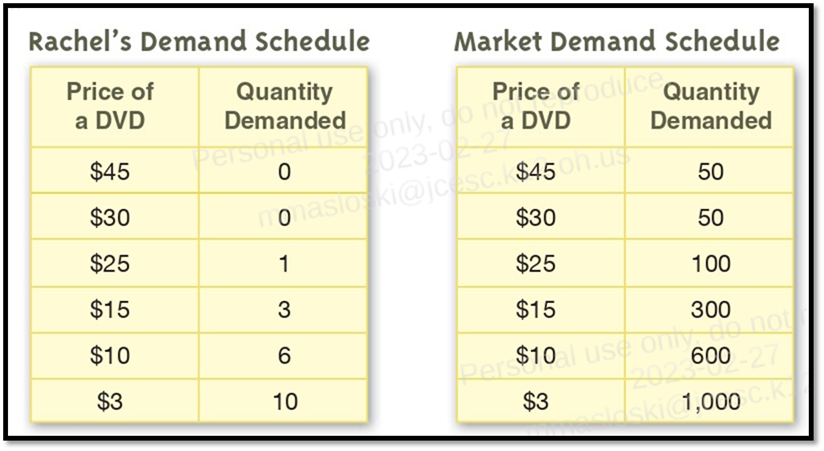Demand
Key Terms
demand: the desire to buy
something and the willingness and ability to pay for it
demand
schedule: a
chart that lists the quantity of a good that people will buy at certain prices
individual
demand schedule: a chart that lists the quantity of a good that one person will
buy at each price
law of
demand: when
the price of a good is lower, people will buy more of it; when the price of a
good is higher, people will buy less of it
market
demand schedule: a chart that lists the quantity of a good that everyone who
wants the good will buy at each price
quantity:
amount
Let's Practice
Demand
In a market economy, buyers want goods, and
sellers provide them. Buyers and sellers help determine the prices of goods and
how much of each good will be produced. In this unit, you will learn about
demand.
Demand is the desire to buy
something and the willingness and ability to pay for it.
Sometimes, people think of demand as the desire
to have a certain product, but it is complex. For example, if you think this
way, you might say that every person who wants an expensive wristwatch demands one. However, not everyone who
wants a high-priced wristwatch can afford one. Demand is not just the desire to
have a certain product. It is also the willingness and ability to pay for that
product.
Let's Practice
The Law of Demand
The law of demand says that when the price of a
good is lower, people will buy more of it.
When the price of a good is higher, people will
buy less of it.

The law of demand can be shown using a demand
schedule. A demand schedule is a chart that lists the quantity, or amount, of a
good that people will buy at each price. For example, the first demand schedule
on the next page shows how many DVDs a sample consumer named Rachel would buy
at a certain price.

By looking at Rachel's demand schedule, you can
see that Rachel would not buy any DVDs for $45 or $30 each but would buy one
DVD if the price dropped to $25. Rachel would buy three DVDs if the price
dropped to $15. Like most people, she would buy even more of the product if the
price was lower.
Rachel's demand schedule shows the demand of
ONE consumer, so it is called an individual demand schedule. Business
owners look at charts that show the demand for EVERYONE who wants to buy the
product. Business owners can use a market demand schedule to predict
the quantities of a good that people will buy at different prices. This
knowledge helps them decide how much they should charge for a product.
Looking at the market demand schedule, you can
see that 50 people would buy a DVD for $45. One thousand people would buy a DVD
for $3. As you can see, when prices go down, demand goes up.
Let's Practice